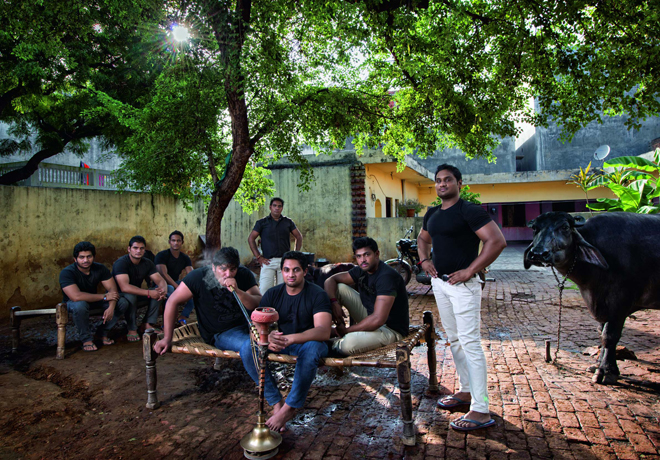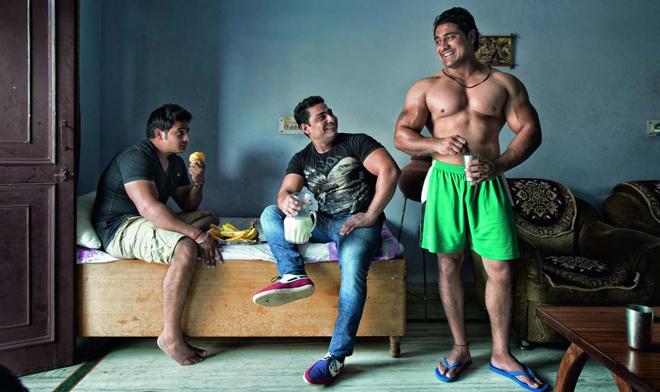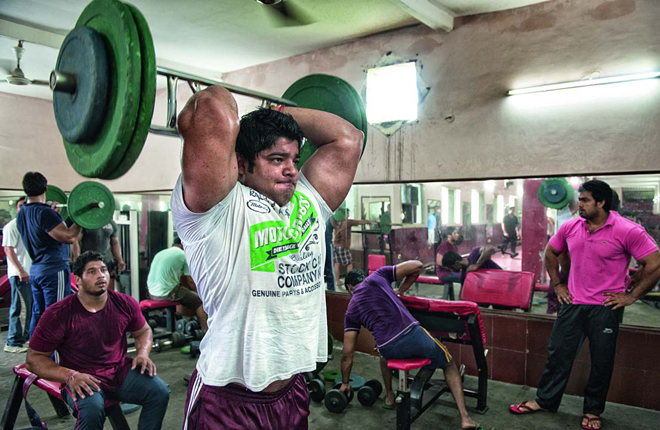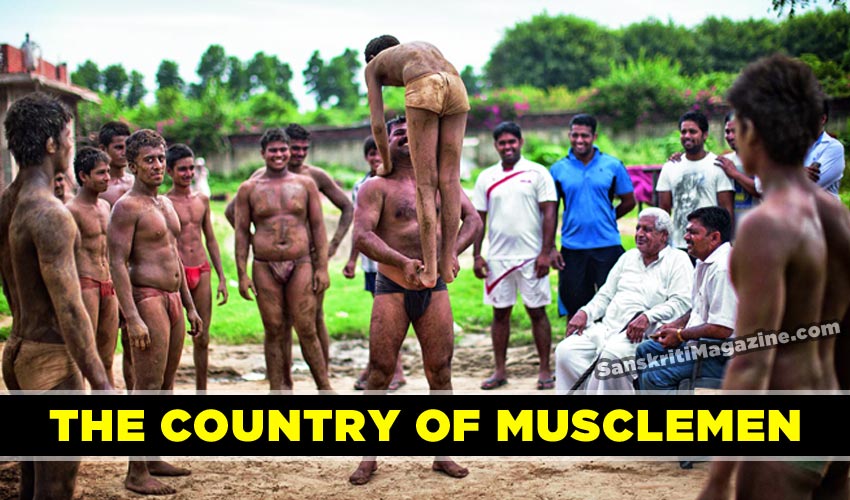Saturday night at the Sahara Mall in Gurgaon. Youngsters reeking of alcohol and cheaper body cheap spray gleefully troop to the third level of the mall and a series of nightclubs, one of which is called Prison. But first they have to pass through a wall of muscle. Three beefy square-jawed bouncers almost identically clad in jeans and bicepbaring tees, arms the size of their thighs, stand before a sign ‘Drugs and ammunition prohibited’ and impassively regard them before rubber-stamping their hands with the entry pass. The youngsters head into the nightclub, a raucous jarring cultural cocktail of waxed-hair young men, with minimally attired women, all set to the accompaniment of blaring Punjabi pop.
The bouncers outside have one thing in common. All of them are from a twin urban village, Asola-Fatehpur Beri near southern Delhi’s exclusive VIP farmhouse belt, Chhatarpur. Caught in a time warp between rural India and emerging India-high walled gated communities with landscaped gardens and garish wedding farmhouses-Fatehpur Beri is where buffaloes slurp feed from disused bathtubs in the concrete monstrosities and SUVS lock air horns with tractors in narrow brick-lined bylanes.

Over 200 youngsters from these villages, with a population of 50,000, provide the muscles that protect bars and nightclubs in the national capital, secure private colleges and guard businessmen. ‘Bouncery’, as they call it, is a perfectly respectable profession in this village dominated by the pastoral Gujjar community. Most of them sport a common surname, Tanwar, worship their ancestors, and frown on ‘love’ marriage.
“Think of us as protectors without whom you can’t run a business,” says Vijay Tanwar, 40, aka Pehalwan. “We are possibly the healthiest village in Delhi, says Vijay Pehalwan. “Our boys don’t smoke, drink or watch porn clips,” he claims. He does worry about a movie which has had a bad influence on the boys in his village. “Ever since they’ve seen Bhaag Milkha Bhaag,” sniffs the wrestler, “they crave sixpacks. They want to be lean.” Lean is an expletive in the village of brawn, where boys see muscles as a ticket to fame. Where the Enfield Bullet is not only the official ride-there are over 100 Bullets registered in the village- but also lifted in impromptu contests to show off strength. Where adequacy is measured by the breadth of your bicep, 19 inches, and weight is how much you can bench.
No one is quite sure when the bouncer surge from the village began but Vijay Pehalwan, sporting a white T-shirt bearing the legend ‘Don’t ask me who Picasso is’, has a story. Fifteen years ago, when he was muddying his legs in the village akhara, a pub owner paid him Rs 10,000 to bring five boys to guard a wedding function in Delhi. The money was a terrific allurement for the village’s small group of recreational wrestlers with little to look forward to except farming or lowpaying government jobs.

As the economic boom of the mid-1990s fueled a mall, then a nightclub and bar boom in the Capital, the owners needed more than skinny security guards to keep the peace. The boys from Asola-Fatehpur Beri filled the void. Classified ads now routinely ask for bouncers. Musclemen are a musthave for weddings, film shoots, malls and even schools, colleges and hospitals. The only prerequisites, for a bouncer who gets paid Rs 1,500 a day, are an impressive physique and no criminal record. Vijay Pehalwan, the trendsetter, now has boys coming to him, touching his feet and asking for career advice. “I generally ask them to study up to Class XII and only then look at this as a serious profession,” he says.
Delhi’s real estate boom also literally turned the ground beneath their feet into gold. Prices have tripled in five years. An acre in Fatehpur Beri costs over Rs 15 crore. Many villagers have sold their pastures to farmhouse developers, investing the money in transport businesses or reinventing themselves as property agents. The rest crowd the gyms as their ticket to class mobility. K.T. Ravindran, former chairman of the Delhi Urban Art Commission, sees Fatehpur Beri and Asola as Delhi’s ancient villages that are now being co-opted into an expanding city with their social fabric left largely intact. “Trends like bouncers are manifest of new subcultures that have grown around money,” he says.
“If so many youngsters are involved in health and fitness, it can only be a good thing,” assures Kartar Singh Tanwar, BJP’s councillor from Bhati area where the villages are.
The Gym, a 3,000 sq ft cement structure lined with weights and machines where youngsters grunt and grind for that pump, displaced the akhara as the single-most important village hangout a decade ago. It opens its creaky doors at 4 a.m. and closes only at 10 p.m. “Our boys are the best in Delhi,” says its proprietor, Raj Tanwar. “When you come up against someone twice your size, you will think twice before taking him on.”
You can tell where the bouncers work judging by the time they come in for their workouts: Those with day jobs come in early, the nightclub crowd comes in around mid-day, after they’ve slept off their late-night shifts. Each of them spends about Rs 300 a day on food, wolfing down, on an average, an entire boiled chicken, 10 egg whites, a dozen bananas and 10 litres of milk (the milk is free because most of them own buffalos). A bouncer earns between Rs 30,000 and Rs 50,000 per month. One bouncer who has hit paydirt is Narender Tanwar, a six-foot, 105-kg, 35-year-old who can bench press 200 kg and, not surprisingly, goes by the nickname ‘Ample’. Ample is on the bodyguard detail of businessman Karan Singh Tanwar, the richest candidate in the fray during Delhi’s 2009 Assembly elections. “I failed in eighth standard; today I earn over Rs 30,000 a month and I carry this,” he says, pulling out a licensed .32 pistol from his belt.
But the profession, with its emphasis on health and fitness, has a sell-by date. It has forced older bouncers to move up the chain and become proprietors. Vijay Pehalwan runs a bouncer agency called ‘Storm Group’, Vinod Tanwar, another former bouncer, now owns four nightclubs in Gurgaon-The Empire, Ignite, Lucia and Powerplay- and is a village icon.

All youngsters claim to abide by a bouncer code-never initiate a fight, never respond to abuse, and control emotions. Fight only when your life is under threat. Sometimes, the code is broken and all hell breaks loose. In August 2011, the village shot to notoriety when its bouncers, working in three pubs in Sahara Mall, beat up youngsters from Chakarpur village in Gurgaon. The bouncers say it began as a fight when the inebriated youngsters went out of control. Both sides called for reinforcements. Fatehpur Beri won. “Eighteen of our bouncer boys flattened hundreds of villagers. It was like a scene out of the movie, 300,” says Rakesh Tanwar, a local. Police swooped down on the village, arrested several bouncers even as authorities suspended the licences of the six pubs and insisted they hire private security guards. The pubs returned in a few months, as did the bouncers. No eyebrows were raised. A brawl occurs in Sahara Mall every few months. The most recent, in February this year, saw seven Afghan nationals being thrashed by bouncers. These incidents have led to some soul searching. The bouncers say they are trying to consolidate all the village boys under one umbrella, a ‘bouncer samaaj’ which will provide cover to its employees.
Not everybody thinks the profession is respectable. “Khade rehte hain. Paisa milta hain. khushi waali baat nahin hain (We get money to keep standing, it’s not a happy situation),” says Kuldeep Tanwar, 27, a bouncer who works at a private college near the village. “Hopefully, the next generation will turn out better. We will have doctors, lawyers, engineers,” he says. Finally, it will be a victory of brain over brawn.
~ IndiaToday, photos by Reuben Singh











